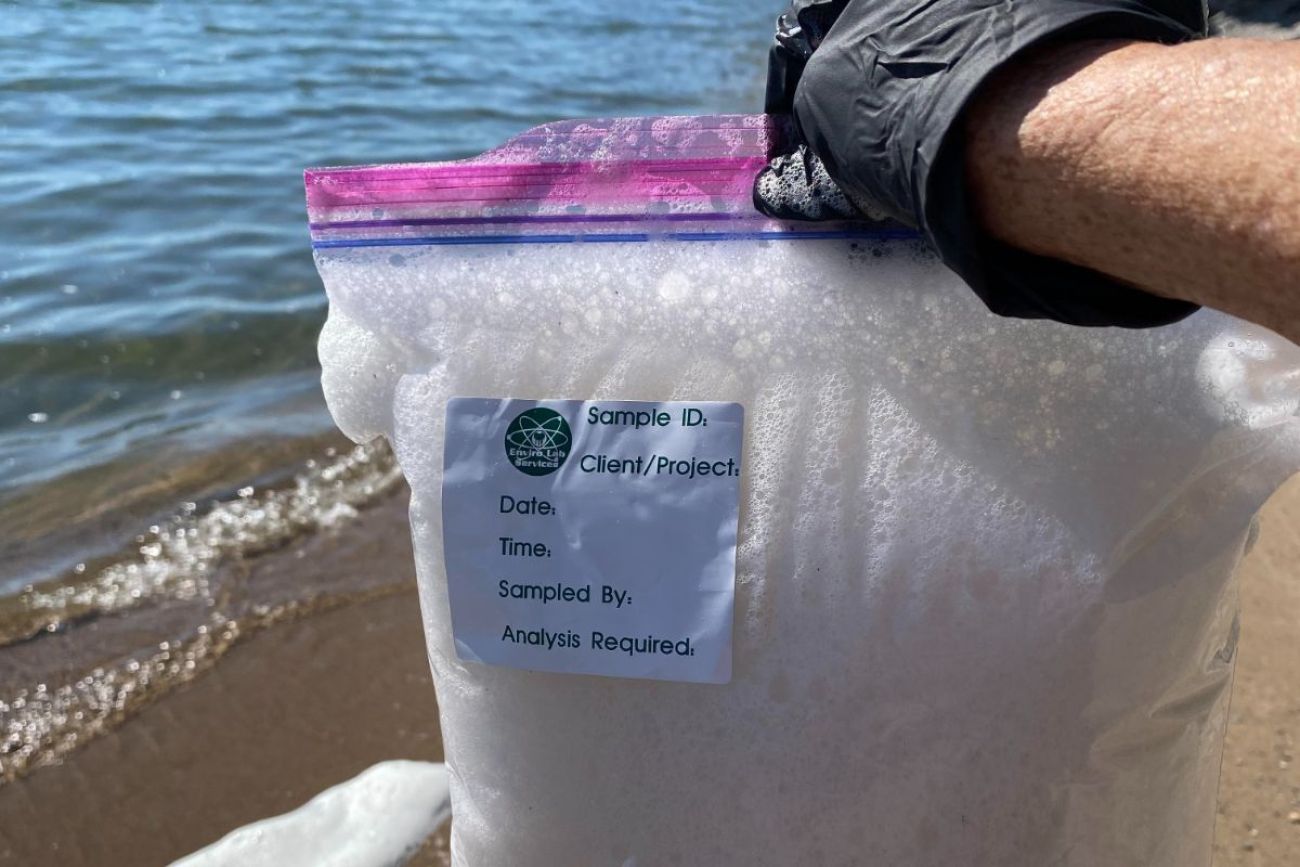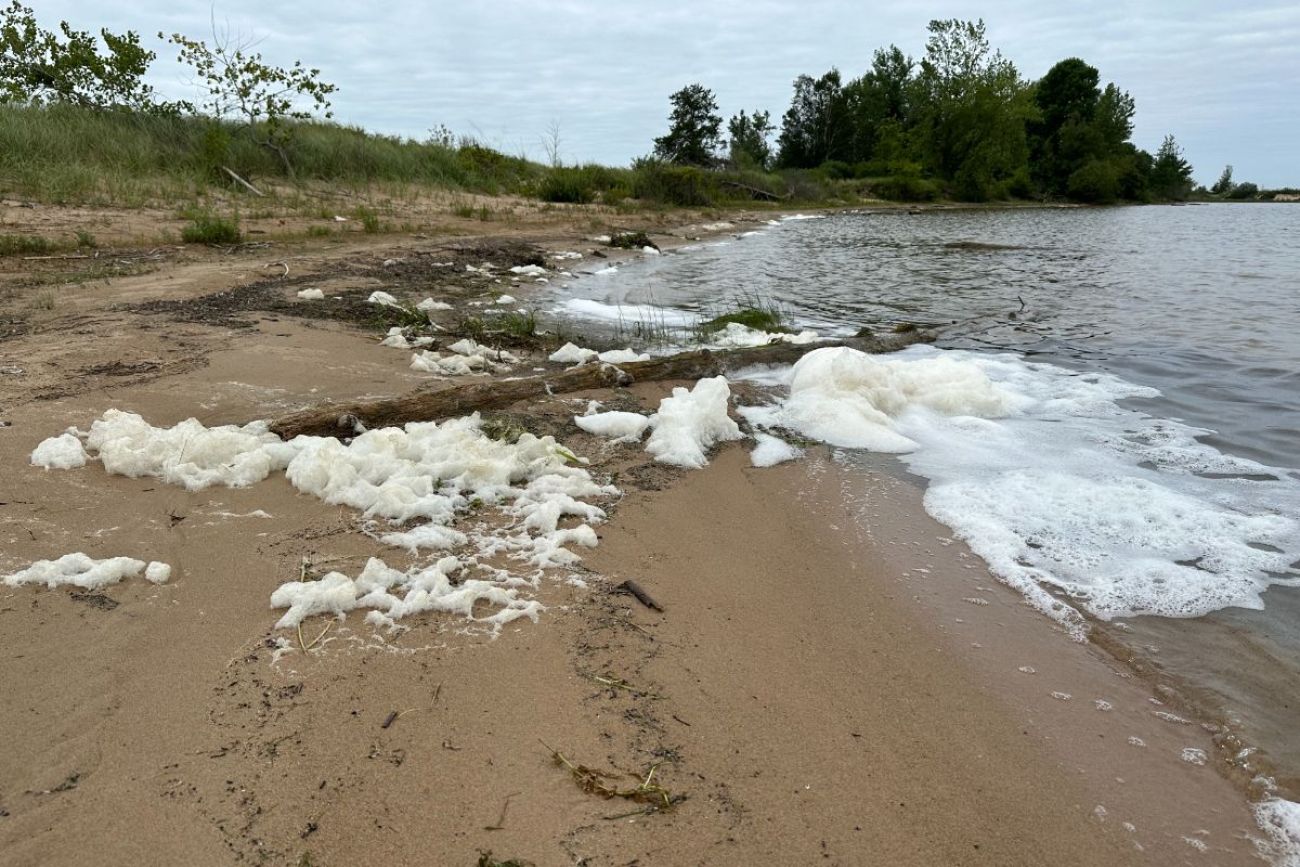PFAS-tainted foam in Lake Huron prompts citizen outcry

- A citizen-led testing effort showed PFAS levels as high as 7,900 parts per trillion in Lake Huron beach foam
- Local activists complain that state officials refused their pleas for testing, while state officials contend limited resources means they can’t test everywhere
- Activists are calling for permanent signage warning swimmers to avoid the foam
Citizen-led testing near a polluted former military base in Oscoda has revealed high levels of toxic “forever chemicals” in Lake Huron’s beach foam, prompting calls for the state to better alert beachgoers to the danger.
Citing test results showing PFAS levels as high as 7,900 parts per trillion, activists on Thursday panned state environmental regulators for declining to test Lake Huron foam despite known contamination at the nearby former Wurtsmith Air Force Base.
“We felt gaslighted when they told us the foam was a ‘natural’ type of foam, so we tested the foam ourselves,” said Cathy Wusterbarth, an Oscoda resident who leads the group Need Our Water. “We found there is nothing natural about the PFAS foam in Lake Huron."
Great Lakes News Collaborative
Bridge Michigan, Circle of Blue, Great Lakes Now at Detroit Public Television, Michigan Public and The Narwhal work together to report on the most pressing threats to the Great Lakes region’s water. This independent journalism is supported by the Charles Stewart Mott Foundation.
Related:
Amid human health fears over PFAS, Michigan weighs new fish guidance
Lakes Michigan and Huron join list of lakes with PFAS-tainted smelt
Wolverine Worldwide faces tough times selling shoes. Then came more PFAS
State officials contend that with limited resources to investigate hundreds of PFAS sites across the state, they must “triage limited resources” to test areas deemed most critical.
Given that state testing has identified contaminated foam in nearby waterways, the high levels in Lake Huron are no surprise, said Hugh McDiarmid, a spokesperson for the state department of Environment, Great Lakes and Energy.
“We haven’t fully reviewed the Ecology Center’s study, but welcome it as an addition to the information we are constantly compiling on PFAS issues statewide,” McDiarmid said.
PFAS, or per- and polyfluoroalkyl substances, accumulate in foam, where levels can be thousands of times higher than the surrounding water. Health officials say the body doesn’t easily absorb PFAS through the skin, but foam presents an ingestion risk, especially for young children.
There is no established health standard for PFAS in beach foam. But for context, federal officials have proposed banning even tiny amounts of PFAS in drinking water.
Working with the National Wildlife Federation and the Ecology Center, citizen scientists collected foam from four beach locations to the north and south of Oscoda between May 2022 and June 2023. The samples were sent to a lab for testing.
Every one contained PFAS, a class of chemicals that has been linked to hormone and thyroid problems, developmental and fertility issues, weakened immune systems and cancer.
The highest hit, 7,900 parts per trillion, came from Tawas Point State Park.

All samples contained perfluorooctane sulfonate, or PFOS, a now-banned ingredient in firefighting foam that was used at Wurtsmith and other military bases, airports and firefighting sites across the country.
The compound PFUnA, which is found in products such as food packaging, furniture and carpets, was also present in every sample.
Those involved in the testing effort are urging the state to conduct its own tests, and put up permanent signs warning swimmers to avoid foam on Oscoda-area beaches.
“Kids and families go to these places, and they touch the stuff,” said Erica Bloom, toxics campaign director for the Ecology Center.
Lynn Sutfin, a spokesperson for the Michigan Department of Health and Human Services, said state officials are reviewing the report and cannot comment on any potential state response.
The state has tested foam at inland lakes and rivers near PFAS sites, prompting advisories at several locations across the state. That includes Van Etten Lake, which abuts Wurtsmith.
And a statewide advisory warns Michiganders to avoid foam when swimming in any Michigan water body, but activists say that’s not enough.
Some foam in Michigan waterways is naturally-occurring, but it can be difficult to distinguish from PFAS foam. The Michigan Department of Health and Human Services recommends avoiding foam in water bodies affected by PFAS contamination (see a list of PFAS sites here).
People who come into contact with foam should bathe or shower afterward, Sutfin said.
Fourteen years after scientists first discovered the Wurtsmith property’s contamination, a full cleanup is still years away.
Tainted groundwater continued to spread for years while residents complained that the military was dragging its feet on cleanup plans. Last August, the Air Force agreed to install more PFAS treatment systems.
Fish consumption advisories
Beyond Oscoda, PFAS has contaminated lakes, rivers and groundwater near military facilities, manufacturing sites and landfills across the state.
Fish in dozens of Michigan waterways are subject to “do not eat” advisories because of PFAS contamination, and the list could soon grow because new research indicates some compounds are more dangerous than previously known.
Because nearly all Michigan water bodies drain into the Great Lakes, it’s no surprise that PFAS contamination has spread into them.
In addition to the foam discovery on Lake Huron, PFAS-contaminated smelt in lakes Superior, Michigan and Huron have prompted fish consumption advisories and further testing to identify other fish species that may be tainted.
In the absence of more testing on Michigan’s beach foam, Wusterbarth of Need Our Water had this advice for Lake Huron beach-goers:
“If you see foam on the beach itself, you should not swim that day,” she said. “That foam is toxic.”
Michigan Environment Watch
Michigan Environment Watch examines how public policy, industry, and other factors interact with the state’s trove of natural resources.
- See full coverage
- Subscribe
- Share tips and questions with Bridge environment reporter Kelly House
Michigan Environment Watch is made possible by generous financial support from:
Our generous Environment Watch underwriters encourage Bridge Michigan readers to also support civic journalism by becoming Bridge members. Please consider joining today.
See what new members are saying about why they donated to Bridge Michigan:
- “In order for this information to be accurate and unbiased it must be underwritten by its readers, not by special interests.” - Larry S.
- “Not many other media sources report on the topics Bridge does.” - Susan B.
- “Your journalism is outstanding and rare these days.” - Mark S.
If you want to ensure the future of nonpartisan, nonprofit Michigan journalism, please become a member today. You, too, will be asked why you donated and maybe we'll feature your quote next time!






